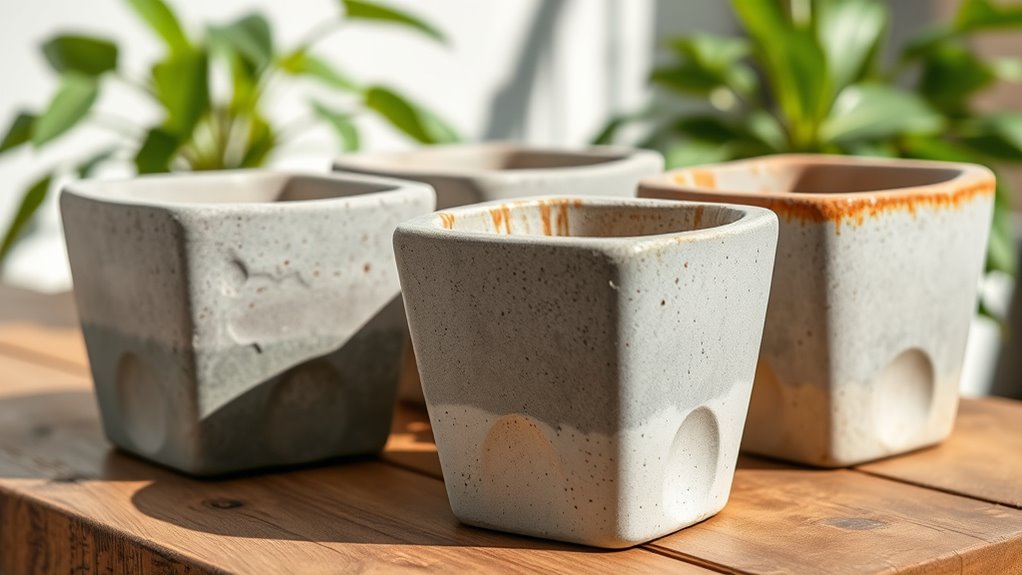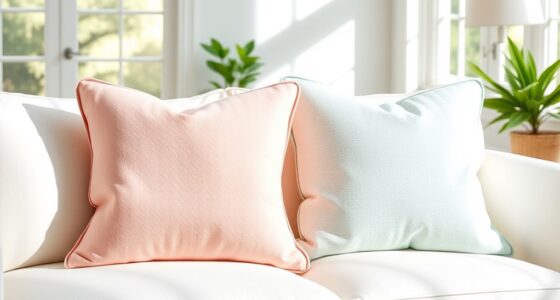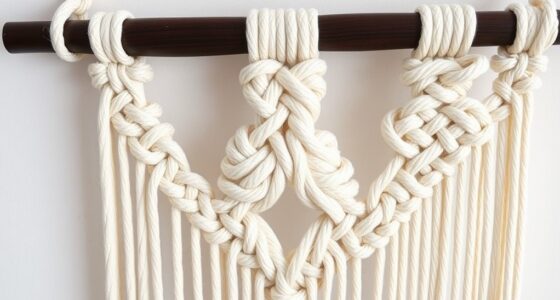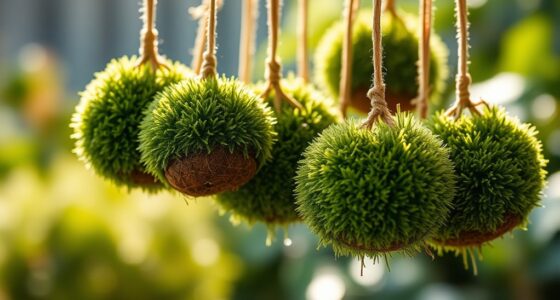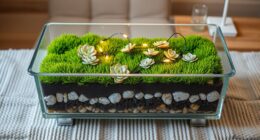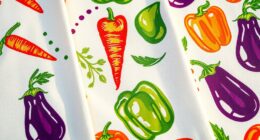You can easily mold concrete planters in recycled cartons like milk, juice, or cereal boxes. Start by reinforcing the cartons with tape or plastic wrap, then cut drainage holes and pour in your mixed concrete. Let it cure for 24-48 hours before carefully peeling away the carton shape. Sand any rough edges for a smooth finish. If you’re interested in transforming discarded containers into eco-friendly, creative planters, keep exploring for more tips and ideas.
Key Takeaways
- Select sturdy, clean cartons like milk or cereal boxes and reinforce them with tape or plastic wrap for durability.
- Customize molds by cutting or layering cartons to achieve unique shapes and drainage features.
- Mix eco-friendly concrete to a thick, workable consistency and pour into cartons, ensuring proper air bubble removal.
- Cure the concrete for 24-48 hours, then carefully demold by peeling away the carton to avoid damage.
- Finish with sanding or natural pigments for personalized, eco-conscious planters suitable for various plants.
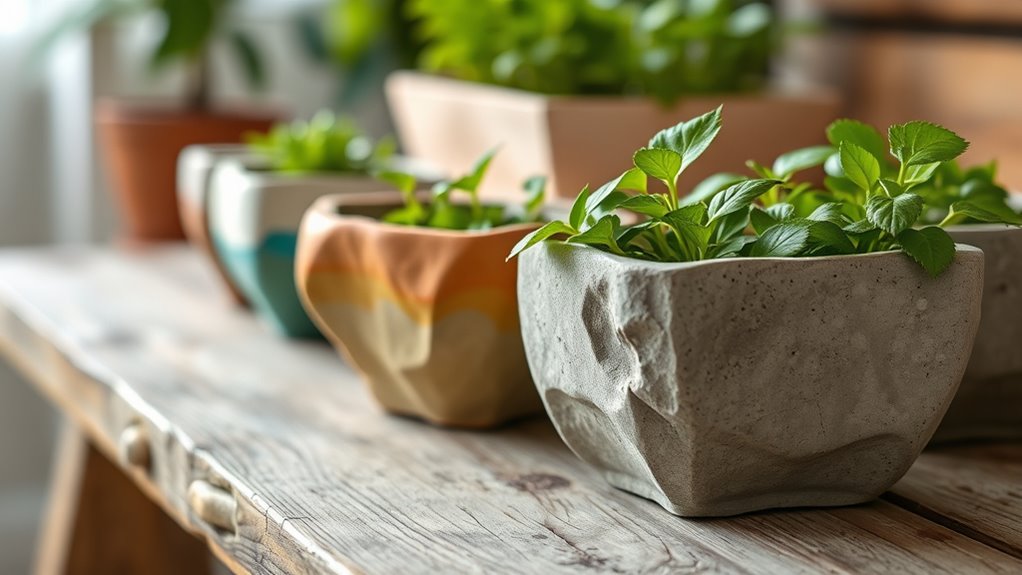
Transforming recycled cartons into concrete planters offers a sustainable and cost-effective way to display your favorite plants. By repurposing materials you might otherwise discard, you not only reduce waste but also create unique, personalized containers for your greenery. The key to this project lies in mastering upcycling techniques—methods that turn everyday items into functional art. Using eco-friendly materials ensures your project remains environmentally conscious, aligning with sustainable living goals.
Start by selecting sturdy, clean recycled cartons—milk cartons, juice boxes, or cereal boxes work well. These containers act as molds, shaping your concrete planters. To make the process smoother, reinforce the cartons with masking tape or plastic wrap, preventing leaks and ensuring the concrete doesn’t seep through any small openings. When it comes to upcycling techniques, think creatively: you can cut holes for drainage or design unique shapes by cutting and layering additional cartons. The goal is to transform what seems like trash into something both beautiful and practical.
Select sturdy, clean recycled cartons and reinforce them with tape or plastic wrap for easy concrete molding.
Mix your concrete using eco-friendly materials whenever possible. Opt for a blend that uses less cement and incorporates natural aggregates like crushed stone or recycled glass. This reduces environmental impact and aligns with eco-conscious principles. When mixing, aim for a thick, workable consistency—this makes it easier to pour into your cartons and helps the final product maintain its shape. You might also consider adding natural pigments or colorants to customize your planters, giving them a personal touch while maintaining an eco-friendly profile.
Pour the concrete into your prepared cartons, filling them to the desired height. Use a stick or a small tool to tap the sides gently, removing air bubbles and ensuring a smooth finish. If your design includes drainage holes, insert a small piece of pipe or a plastic bottle cap before the concrete sets. Allow the concrete to cure for at least 24 to 48 hours in a dry, shaded area. Once hardened, carefully peel away the carton mold—start from the edges and work inward, being gentle to avoid chipping the concrete. If needed, sand any rough edges for a polished look. Incorporating upcycling techniques not only enhances the design but also reinforces the sustainable aspect of your project.
This process allows you to create durable, eco-friendly planters that reflect your creativity and commitment to sustainability. Using upcycling techniques preserves resources, reduces waste, and results in one-of-a-kind containers that can hold everything from succulents to herbs. The best part? You get to enjoy the satisfaction of turning discarded cartons into functional art, all while caring for the environment. So, gather your materials, embrace your creativity, and start molding your concrete planters from recycled cartons today.
Frequently Asked Questions
Are Recycled Carton Planters Durable Outdoors?
You might wonder if recycled carton planters can withstand outdoor conditions. While carton durability varies, these planters generally have limited outdoor resilience because paper-based materials tend to degrade when exposed to moisture and sunlight. To improve their outdoor resilience, consider sealing the cartons with a waterproof coating. Keep in mind, for long-term durability, traditional materials like concrete often outperform paper-based options in outdoor environments.
How Do I Prevent Mold in Recycled Carton Planters?
Imagine your recycled carton planter thriving, vibrant with healthy plants, free from mold. To prevent mold, you need to control moisture—avoid overwatering and guarantee proper drainage. Use a layer of gravel or small stones at the bottom and let the soil dry out between waterings. Regularly check for excess moisture and air out the planter. These simple steps will help you maintain mold prevention and keep your planter looking fresh and healthy.
Can These Planters Be Painted or Decorated?
You can definitely paint or decorate these planters. Use creative painting ideas like bright colors or patterns, or try decorative techniques such as stenciling or adding textured finishes. Before painting, make sure the surface is clean and dry. Seal your designs with a waterproof sealant to protect them from moisture. This way, your recycled carton planters become personalized and vibrant, adding a unique touch to your garden or indoor space.
What Types of Plants Are Best Suited for Carton Planters?
You should choose plants that thrive in small, well-drained containers, like succulent varieties or herbs. These plants are ideal because they don’t require deep soil or frequent watering, making them perfect for carton planters. You’ll want to guarantee proper drainage and place your planters where they get adequate sunlight. Succulents and herbs are low-maintenance, easy to grow, and add beauty and practicality to your recycled carton garden.
How Eco-Friendly Are These Recycled Carton Planters?
Did you know recycling helps reduce waste by 30%? When you use recycled carton planters, you’re actively lowering the environmental impact. These planters are eco-friendly because they involve a simple recycling process that repurposes cartons, cutting down on landfill waste. By choosing them, you support sustainable practices and reduce your carbon footprint, making your gardening habits more environmentally responsible and beneficial for the planet.
Conclusion
Now that you know how simple it is to craft concrete planters from recycled cartons, you’re blending sustainability with creativity. It’s fascinating how something as fragile as a cardboard carton can transform into a sturdy, beautiful planter. This mix of eco-friendliness and craftsmanship reminds you that the most unexpected materials can yield the most inspiring results. So, embrace your DIY spirit, and watch your recycled cartons turn into charming, eco-conscious additions to your home.
